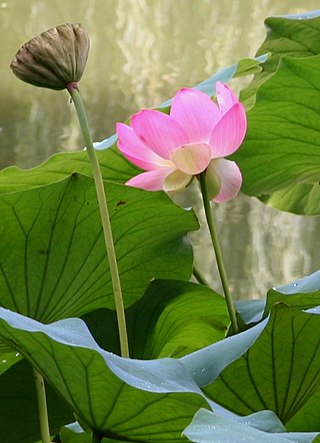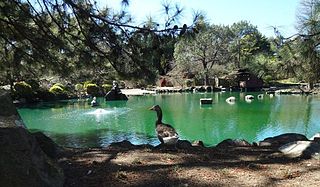
Gardening is the process of growing plants for their vegetables, fruits, flowers, herbs, and appearances within a designated space. Gardens fulfill a wide assortment of purposes, notably the production of aesthetically pleasing areas, medicines, cosmetics, dyes, foods, poisons, wildlife habitats, and saleable goods. People often partake in gardening for its therapeutic, health, educational, cultural, philosophical, environmental, and religious benefits.

A garden is a planned space, usually outdoors, set aside for the cultivation, display, and enjoyment of plants and other forms of nature. The single feature identifying even the wildest wild garden is control. The garden can incorporate both natural and artificial materials.

A botanical garden or botanic garden is a garden with a documented collection of living plants for the purpose of scientific research, conservation, display, and education. It is their mandate as a botanical garden that plants are labelled with their botanical names. It may contain specialist plant collections such as cacti and other succulent plants, herb gardens, plants from particular parts of the world, and so on; there may be glasshouses or shadehouses, again with special collections such as tropical plants, alpine plants, or other exotic plants that are not native to that region.

Robert Adrian de Jauralde Hart was an English pioneer of forest gardening in temperate zones. He created a model forest garden from a 0.12 acre (500 m²) orchard on his farm. He credits the inspiration for his work to an article by James Sholto Douglas, which was in turn inspired by the work of Toyohiko Kagawa.

Topiary is the horticultural practice of training perennial plants by clipping the foliage and twigs of trees, shrubs and subshrubs to develop and maintain clearly defined shapes, whether geometric or fanciful. The term also refers to plants which have been shaped in this way. As an art form it is a type of living sculpture. The word derives from the Latin word for an ornamental landscape gardener, topiarius, a creator of topia or "places", a Greek word that Romans also applied to fictive indoor landscapes executed in fresco.

The early history of gardening is largely entangled with the history of agriculture, with gardens that were mainly ornamental generally the preserve of the elite until quite recent times. Smaller gardens generally had being a kitchen garden as their first priority, as is still often the case.

A parterre is a part of a formal garden constructed on a level substrate, consisting of symmetrical patterns, made up by plant beds, plats, low hedges or coloured gravels, which are separated and connected by paths. Typically it was the part of the garden nearest the house, perhaps after a terrace. The view of a parterre from inside the house, especially from the upper floors, was a major consideration in its design. The word "parterre" was and is used both for the whole part of the garden containing parterres and for each individual section between the "alleys".

A knot garden is a garden style that was popularized in 16th century England and is now considered an element of the formal English garden. A knot garden consists of a variety of aromatic and culinary herbs, or low hedges such as box, planted in lines to create an intertwining pattern that is set within a square frame and laid on a level substrate. The spaces between these lines are often filled with stone, gravel, sand or flowering plants. Traditional plants used in knot gardens include germander, marjoram, thyme, southernwood, lemon balm, hyssop, costmary, acanthus, mallow, chamomile, rosemary, calendula, viola and santolina.

The cottage garden is a distinct style that uses informal design, traditional materials, dense plantings, and a mixture of ornamental and edible plants. English in origin, it depends on grace and charm rather than grandeur and formal structure. Homely and functional gardens connected to cottages go back centuries, but their stylized reinvention occurred in 1870s England as a reaction to the more structured, rigorously maintained estate gardens with their formal designs and mass plantings of greenhouse annuals.

Ganna Walska Lotusland, also known as Lotusland, is a non-profit botanical garden located in Montecito, near Santa Barbara, California, United States. The garden is the historic estate of Madame Ganna Walska. The County of Santa Barbara restricts visitation via a conditional use permit: Lotusland botanic garden is open to the public by reservation only, with walking tours 1½ to 2 hours long.

The Reeves-Reed Arboretum is a nonprofit arboretum and garden located at 165 Hobart Avenue in Summit, Union County, New Jersey, United States. It is the only arboretum in Union County. A popular wedding spot, the arboretum grounds are open daily from dawn till dusk, free of charge.

The George Griswold Frelinghuysen Arboretum is an arboretum located at 353 East Hanover Avenue, Morris Township, New Jersey. It is open daily without charge. It is also the headquarters of the Morris County Parks Commission.
This is an alphabetical index of articles related to gardening.

The traditional kitchen garden, vegetable garden, also known as a potager or in Scotland a kailyaird, is a space separate from the rest of the residential garden – the ornamental plants and lawn areas. It is used for growing edible plants and often some medicinal plants, especially historically. The plants are grown for domestic use; though some seasonal surpluses are given away or sold, a commercial operation growing a variety of vegetables is more commonly termed a market garden. The kitchen garden is different not only in its history, but also its functional design. It differs from an allotment in that a kitchen garden is on private land attached or very close to the dwelling. It is regarded as essential that the kitchen garden could be quickly accessed by the cook.

The Gardens of Monticello were gardens first designed by Thomas Jefferson for his plantation Monticello near Charlottesville, Virginia. Jefferson's detailed historical accounts of his 5,000 acres provide much information about the ever-changing contents of the gardens. The areas included a flower garden, a fruit orchard, and a vegetable garden. Jefferson, a connoisseur of trees, flowers, and gardening techniques, was highly interested in experimental planting and directed the design of the gardens, which contained many exotic seeds and plants from his travels abroad.

Foodscaping is a modern term for integrating edible plants into ornamental landscapes. It is also referred to as edible landscaping and has been described as a crossbreed between landscaping and farming. As an ideology, foodscaping aims to show that edible plants are not only consumable but can also be appreciated for their aesthetic qualities. Foodscaping spaces are seen as multi-functional landscapes that are visually attractive and also provide edible returns. Foodscaping is a method of providing fresh food affordably and sustainably.

Gardening in Scotland, the design of planned spaces set aside for the display, cultivation, and enjoyment of plants and other forms of nature in Scotland began in the Middle Ages.

Gardening in Australia reflects the different styles of Australian art, including influences from Roman, Islamic, Italian, French, and English gardens. Modern Australian gardening emphasize gardens and their surroundings, focusing heavily on both urban horticulture and landscape architecture.

















